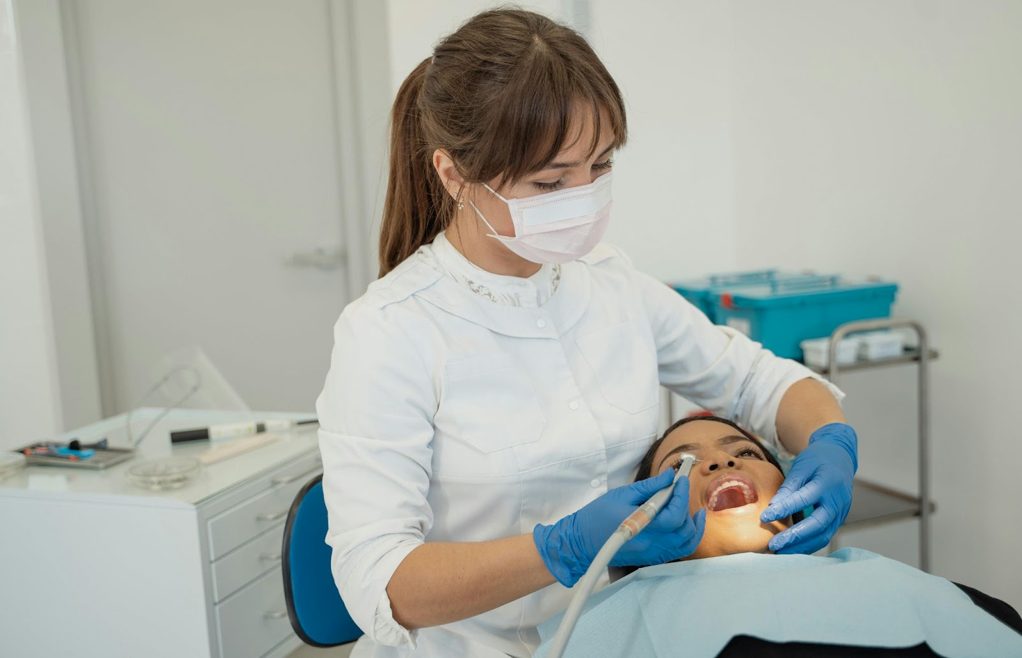
@ShahidNShah


Preventive dental care is a cornerstone of maintaining ideal oral health, as emphasized by dentists in Live Oak. It involves regular check-ups, effective oral hygiene practices, and a balanced diet. Routine visits are essential for early detection of issues like cavities and oral cancer. Proper brushing and flossing techniques are critical to eliminate plaque. Understanding these elements and their impact can greatly influence dental wellness, prompting further exploration into personalized care strategies.
Regular dental check-ups are a crucial component of preventive dental care, as they enable the early detection and treatment of oral health issues before they become major problems. These visits allow dental professionals to screen for serious conditions such as oral cancer, which may not exhibit symptoms in its early stages. The early identification of such conditions greatly improves treatment outcomes, emphasizing the necessity of regular examinations. However, dental anxiety can often deter individuals from seeking these essential services. Addressing dental anxiety through patient education and communication is important, as it encourages individuals to maintain consistent dental appointments. By prioritizing regular check-ups, individuals benefit from thorough evaluations that not only identify potential pathologies but also promote overall oral health, thereby mitigating future complications.
Effective oral hygiene is foundational to preventive dental care, encompassing proper brushing and flossing techniques to remove plaque and prevent cavities. Adhering to these practices, alongside regular dental checkups, plays a critical role in maintaining oral health and detecting potential issues early. Understanding these basics equips individuals with the tools necessary to sustain long-term dental well-being.
Mastering the fundamentals of brushing and flossing is essential for maintaining ideal oral hygiene. Effective brushing techniques involve selecting an appropriate toothpaste, tailored to specific dental needs, such as fluoride for cavity prevention or desensitizing agents for sensitive teeth. Toothpaste selection plays a vital role in enhancing the cleaning process and ensuring thorough oral care. The recommended brushing frequency is twice daily, for at least two minutes each session, using a soft-bristled toothbrush to avoid enamel damage and gum recession. Proper brushing involves angling the brush at 45 degrees to the gum line, using gentle circular motions. Complementary to brushing, flossing daily removes plaque and food particles from interdental spaces, preventing periodontal disease. Together, these practices form the cornerstone of preventive dental care.
Although daily brushing and flossing are essential components of oral hygiene, regular dental checkups are indispensable for thorough preventive care. Visiting a dentist in Live Oak ensures that patients receive comprehensive evaluations tailored to their needs. These checkups allow for the early detection of potential issues such as cavities, gum disease, and oral cancer, which might not be visible to the untrained eye. A professional examination provides an opportunity for patient education, where individuals can learn effective oral care practices. Furthermore, addressing concerns related to dental anxiety during these visits can enhance a patient’s comfort and willingness to maintain consistent appointments. Regular checkups also facilitate professional cleaning, removing plaque and tartar buildup that regular brushing cannot eliminate. Consequently, these appointments are crucial in sustaining oral health and preventing long-term dental complications.
When selecting a toothbrush and toothpaste, how does one guarantee both efficacy and suitability for individual dental needs? Evaluating toothbrush types is essential, as they vary in bristle hardness, head size, and handle design. Soft-bristled brushes are generally recommended for most individuals to prevent enamel erosion and gum damage. Electric toothbrushes may offer enhanced plaque removal compared to manual options.
In choosing toothpaste, attention to toothpaste ingredients is vital. Fluoride remains a key component for cavity prevention, while other ingredients like triclosan can offer antibacterial benefits. For those with sensitivity, toothpaste containing potassium nitrate or strontium chloride may be beneficial. Whitening pastes, containing mild abrasives or hydrogen peroxide, should be used with caution to avoid enamel abrasion. Ultimately, selection should align with specific dental conditions and professional advice.
Flossing is a critical component of oral hygiene, effectively removing plaque and food particles from areas a toothbrush cannot reach. Simplified techniques, such as the use of interdental brushes or pre-threaded flossers, contribute to improved accessibility and user compliance. Beyond maintaining clean teeth, regular flossing is associated with a reduction in the risk of periodontal disease and systemic health issues linked to oral bacteria.
How essential is proper flossing to maintain ideal oral health? Flossing is critical as it removes plaque and food particles between teeth where a toothbrush cannot reach. Employing effective techniques guarantees thorough cleaning. The recommended flossing strategies involve using about 18 inches of dental floss, winding most of it around the middle finger of one hand, and a small amount around the opposite middle finger. This allows for clean sections of floss to be used as one progresses through different teeth. Gently sliding the floss between teeth and forming a C-shape enables contact with the tooth surface beneath the gumline. Repeating this motion for each tooth is important. Such attention to detail enhances plaque removal and promotes peak oral hygiene.
Proper flossing techniques not only contribute to basic oral hygiene by removing plaque and food particles but also play a significant role in maintaining overall oral health. Regular flossing reduces the risk of periodontal disease, a common condition that can lead to tooth loss if left untreated. By preventing such dental issues, individuals may achieve long term savings on costly dental procedures. Furthermore, flossing supports overall health by minimizing the risk of systemic conditions linked to oral bacteria, such as heart disease and diabetes. Studies indicate that oral health is closely connected to overall health, reinforcing the importance of daily flossing. Fundamentally, while flossing is a simple practice, its implications extend far beyond the scope of maintaining clean teeth.
While often overlooked, diet plays an essential role in maintaining dental health, influencing both the integrity of tooth enamel and the health of gums. A diet rich in essential nutrients such as calcium, vitamin D, and phosphorus contributes considerably to the development and maintenance of strong tooth structures. These nutrients impact the remineralization process, which is crucial for repairing daily enamel wear. Conversely, excessive sugar consumption poses a substantial risk to dental health. Sugars serve as substrates for oral bacteria, which produce acids that demineralize enamel, leading to cavities. High-sugar diets also contribute to plaque formation, escalating the risk of periodontal disease. Therefore, dietary choices directly affect oral health outcomes, making mindful consumption critical for preventive dental care.
Identifying early signs of dental issues is essential for effective prevention and treatment. Dental professionals emphasize the importance of recognizing early symptoms to mitigate potential damage and maintain oral health. One of the primary indicators is dental sensitivity, often manifesting as discomfort or pain when consuming hot, cold, or sweet substances. This sensitivity can indicate enamel erosion or the onset of cavities. Additionally, persistent bad breath, or halitosis, may signal gum disease or other underlying dental problems. Swollen or bleeding gums during brushing or flossing also serve as early warning signs of periodontal issues. Regular dental check-ups are vital for the early detection and management of these symptoms, enabling timely intervention and minimizing the risk of more severe complications.
Brushing teeth effectively requires mastery of technique to guarantee ideal oral health. Selecting appropriate toothbrush types is vital; options include manual and electric toothbrushes, each offering distinct benefits. Manual toothbrushes provide control over pressure and movement, while electric models may enhance plaque removal through oscillating or sonic actions. Brushing frequency is equally significant in maintaining dental hygiene. The American Dental Association advises brushing twice daily, ideally in the morning and before bedtime, for two minutes each session. Proper technique involves angling the toothbrush at 45 degrees towards the gum line, using gentle circular motions. Ascertain coverage of all tooth surfaces, including the tongue, to remove bacteria and prevent plaque buildup. Regular toothbrush replacement every three to four months is recommended.
Why are professional dental cleanings an important component of oral health maintenance? Regular cleanings play a significant role in promoting dental hygiene by effectively removing plaque and tartar that daily brushing and flossing may miss. Plaque removal is essential as its accumulation can lead to tooth decay and gum disease. During a professional cleaning, a dental hygienist utilizes specialized tools to meticulously clean each tooth surface, ensuring thorough plaque removal. This process not only enhances oral hygiene but also prevents potential periodontal issues. Professional cleanings also allow for early detection of dental problems, facilitating timely intervention. Ultimately, these cleanings act as a preventive measure, maintaining oral health and contributing to the longevity of teeth and gums, thereby reducing future dental costs.
Building on the importance of professional dental cleanings, preventive treatments and solutions encompass a broader range of strategies aimed at maintaining oral health and preventing disease. Preventive treatments include fluoride applications, dental sealants, and antimicrobial therapies, each serving distinct protective roles. Fluoride applications strengthen enamel, enhancing resistance to decay, while dental sealants provide a barrier against plaque accumulation in occlusal surfaces of molars. Antimicrobial therapies target harmful bacteria, reducing the risk of periodontal disease. Oral solutions extend to personalized care plans, stressing proper brushing, flossing techniques, and dietary advice. These strategies are designed to address individual needs, mitigating potential risks associated with dental caries and gum disease. Collectively, these preventive measures are fundamental in fostering long-term oral health resilience.
Smoking consequences greatly impact oral hygiene by increasing the risk of gum disease, tooth discoloration, bad breath, and oral cancer. This habit impairs saliva production, which is essential for maintaining a healthy oral environment and preventing decay.
Dental issues can indeed be hereditary. A genetic predisposition to conditions like gum disease, tooth decay, or misalignment may exist. Evaluating family history provides valuable insights into potential dental challenges an individual might face.
Proper children’s oral hygiene involves brushing twice daily with fluoride toothpaste, flossing, and limiting sugary snacks. Regular pediatric dental checkups every six months are essential for monitoring development, preventing cavities, and addressing potential issues early.
Electric toothbrush benefits include enhanced plaque removal and improved gum health, while manual toothbrush effectiveness depends on proper technique and consistency. Studies suggest electric models can be more efficient, but both types can be effective with correct use.
Stress can negatively impact oral health by contributing to conditions like bruxism and gum disease. Effective stress management and understanding anxiety effects are essential in maintaining ideal dental hygiene and preventing related oral health issues.

Local pediatric dental specialists have mastered the art of turning dental visits into pleasant experiences for children. They understand that a child’s anxiety often stems from fear of the unknown or …
Posted Apr 2, 2025 Dental Care Dentistry
Connecting innovation decision makers to authoritative information, institutions, people and insights.
Medigy accurately delivers healthcare and technology information, news and insight from around the world.
Medigy surfaces the world's best crowdsourced health tech offerings with social interactions and peer reviews.
© 2025 Netspective Foundation, Inc. All Rights Reserved.
Built on Apr 4, 2025 at 3:36am